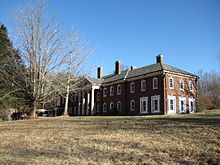Massachusetts Audubon Society
| Massachusetts Audubon Society (MassAudubon) |
|
|---|---|
| legal form | Conservation organization |
| founding | 1896 |
| founder | Harriet Hemenway , Minna B. Hall |
| Seat | Lincoln , Massachusetts , United States ( ⊙ ) |
| purpose | Bird protection |
| Action space | Massachusetts state |
| Chair | Henry Tepper |
| sales | $ 21 million (2013) |
| Members | 100,000+ |
| Website | www.massaudubon.org |
The Massachusetts Audubon Society ( MassAudubon for short ) is a non-profit nature conservation organization founded in 1896 with a focus on bird protection . It is headquartered in Lincoln in the state of Massachusetts of the United States . In 2013, it had 100,000 members and generated revenues of nearly $ 21 million. With these resources, it manages a total area of more than 140 km² in cooperation with over 14,000 volunteers in 55 designated protected areas.
history
The organization, named after the ornithologist John James Audubon , was founded in 1896 by Harriet Hemenway and her cousin Minna B. Hall. The two women wanted to do something about the fact that the bird feathers with which they adorned their hats were mostly obtained with brutal methods and without consideration, and quickly found other interested women and men. The name "Audubon Society" they took over from the predecessor organization of today's National Audubon Society founded by George Bird Grinnell in New York City in 1886 . However, since this was dissolved shortly after it was founded, the Massachusetts Audubon Society is the oldest bird protection organization in the United States today. From a global perspective, only the English associations Selborne Society (founded in 1895) and Royal Society for the Protection of Birds (founded in 1889) are active longer. In the USA, MassAudubon served as a model for the establishment of similar organizations in the other states and led to the re-establishment of the National Audubon Society in 1905.
Shortly after it was founded, the organization supported well-known American scientists such as Edward Howe Forbush , George Mackay and Charles Sedgwick Minot , who had good relationships with the biologist Louis Agassiz at Harvard University . William Brewster was elected the Society's first president and served from 1896 to 1913. This personality helped the MassAudubon to become immediately nationally known, which the founders around Harriett Hemenway had also intended, since in each of the then 48 states of the USA feather headdresses on women's hats - the more and the more exotic birds, the better - were in fashion. As a result, similar bird protection organizations were founded in other states.
The massive political efforts of the MassAudubon led to a law in 1897 banning the trade in feathers from wild birds in Massachusetts. In 1898, Senator George Frisbie Hoar introduced a bill to the United States Congress that would ban the trade, transport, and import and export of feathers within the United States. However, the draft was rejected. Two years later , Congressman John F. Lacey from Iowa submitted another draft on this subject, the content of which was limited to banning the transport of animals or animal products between states if they were in violation of the laws of the exporting state had been killed. This draft was adopted and incorporated into law now known as the Lacey Act of 1900 . The new law was passed with the help of field workers, and the fact that Theodore Roosevelt - a friend of the Minot family and a former member of the Brewster-run Nuttall Ornithological Club - was elected President of the United States in 1901 also helped for implementation.
Finances
From the beginning, the Society relied on donations. The Treasurer's report from 1897 shows revenues of 3,322.12 US dollars (about 105,500 US dollars today) and expenditure of 1,317.93 US dollars (now about 41,800 US dollars) from what a lot of interest in the population closes. The 2013 fiscal year financial report, on the other hand, reveals an operating loss of nearly $ 250,000 on revenues of just under $ 21 million. However, through additional income from inheritances, this could be converted into a positive overall result. The organization used over 70% of its funds to maintain its protected areas and educational programs.
Strategic goals
MassAudubon is of the opinion that an ever-decreasing connection between humans and nature, the progressive loss of natural habitats and climate change represent three elementary threats to the environment in Massachusetts and has defined these topics as the main focus of the Society's work. The organization would like to counter the challenges with four strategic goals, which were laid down in a "Strategic Plan 2015": People should be brought closer to nature again, the protection of habitats should be expanded, an answer to climate change should be found and the capacity of the organization should be further expanded.
Protected areas
The Massachusetts Audubon Society maintains a total of 55 protected areas, which they consistently refer to as wildlife sanctuaries . The largest protected area is the 1,971 acres (8 km² ) Moose Hill Wildlife Sanctuary near Sharon , the Nahant Thicket Wildlife Sanctuary in Nahant is the smallest with an area of only 4 acres (1.6 ha).
Individual evidence
- ^ A b c John H. Mitchell: The Mothers of Conservation. (PDF) In: Sanctuary - The Journal of the Massachusetts Audubon Society. 1996, accessed July 22, 2014 .
- ^ A b Winthrop Packard: The Story of the Audubon Society. (PDF) December 1921, accessed on July 21, 2014 (English).
- ↑ Annual Report 2013. (PDF) Massachusetts Audubon Society, 2013, p. 11 , accessed on July 21, 2014 .
- ↑ Strategic Plan 2015. (PDF) Massachusetts Audubon Society, 2010, accessed July 23, 2014 .
- ^ Wildlife Sanctuaries List. Massachusetts Audubon Society, accessed July 23, 2014 .

